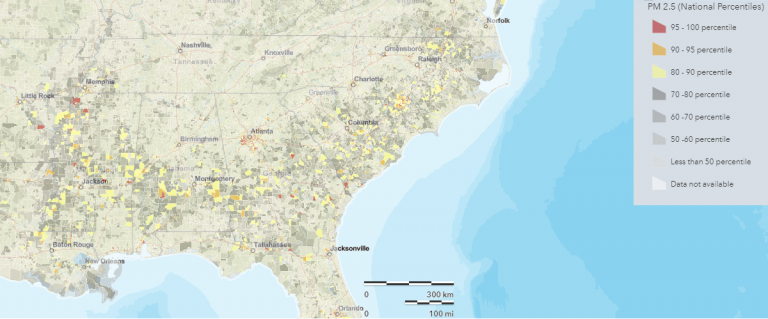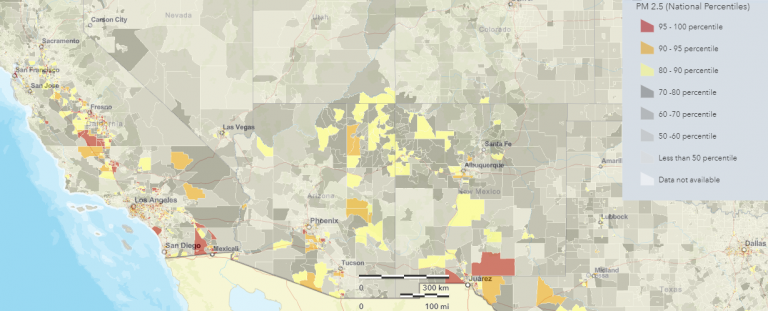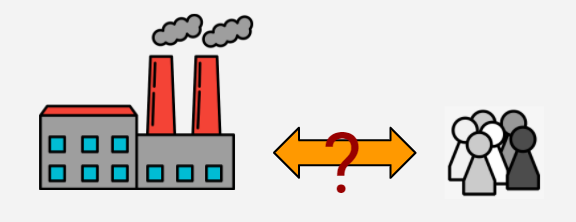Breathing Data

By Ellen Considine
Environmental Justice and Air Inequality
The US Environmental Protection Agency defines environmental justice as “the fair treatment and meaningful involvement of all people regardless of race, color, national origin, or income with respect to the development, implementation and enforcement of environmental laws, regulations and policies”. Environmental injustice occurs when a subpopulation bears a disproportionate share of the negative environmental consequences of private or public sector operations (US EPA).
Here are some example maps illustrating the distribution of environmental injustice in the southern US, obtained from the EJSCREEN Mapper on May 28, 2021. EJSCREEN indices combine exposure to environmental pollution (in this case, PM2.5) with measures of low-income and racial/ethnic minority status. Areas with more environmental injustice are shown in redder colors.


Injustice with respect to air pollution has been termed air inequality. In my first blog, I provided a global perspective on the distribution of health degradation from air pollution. Here, I dig deeper into the evidence of air inequality within countries, focusing on the US because this is where a large amount of environmental justice research has been carried out.
Overall, air pollution levels in the US have been decreasing over time. Between 2002 and 2015, PM2.5 exposures declined by about 50%. However, inequalities in air pollution exposure between socioeconomic and demographic groups have been increasing, on average. From 2010 to 2016, inequality in exposure to PM2.5 greater than 8𝜇g/m3 increased by 1.6 times across racial/ethnic groups and by 4 times across income groups. By 2016, Black people in America were exposed to 11.6% higher average PM2.5 concentrations than white people, and people with incomes in the lowest 30% were exposed to 6.9% higher average PM2.5 concentrations than people with incomes in the highest 30%. Also, while air pollution exposure estimates are often based on ambient (outdoor) air pollution measurements, there is evidence of significant disparities in indoor air pollution as well.
Not only are non-Hispanic white people exposed to lower levels of air pollution than other groups, they also on average are exposed to about 17% less air pollution than is caused by their consumption of goods and services. This imbalance is referred to as a “pollution advantage”. By contrast, Black and Hispanic people on average experience “pollution burdens” of about 56% and 63% respectively, meaning that both groups are exposed to more than 1.5 times the air pollution caused by their consumption of goods and services.
What processes underlie these inequalities in air pollution exposure? Two common explanations are (a) that polluted areas tend to have lower property values, so people with low incomes find it easier to move into those areas and (b) that polluting industries site new facilities in areas with lower-income and/or less-educated communities, anticipating less political resistance than they would face in areas with higher-income and/or more-educated communities.

Research investigating which of these explanations holds more weight has produced mixed findings, but leans in the direction of disparate siting of polluting facilities near disadvantaged populations. Race/ethnicity comes into play because of the substantial wealth disparities among racial/ethnic groups observed in the US.
Beyond being exposed to higher levels of air pollution, people in disadvantaged communities may also experience worse health outcomes as a result of the same amounts of air pollution. Studies from the US, Hong Kong, and Italy, to name a few, have found stronger associations between air pollution and adverse health outcomes in populations with low socioeconomic status. As I mentioned in my second blog, this phenomenon is called effect modification by socioeconomic status, and is most often attributed to the higher chronic health burden and lesser access to health information and services experienced by low-income populations. On this note, I’ve included links to some pieces by other HPHR Fellows at the end of this post in case you’re interested in learning more about the systemic underpinnings of health inequity.
What Can Be Done?
The joint nature of the environmental injustice problem offers opportunities for progress in the spaces of environmental cleanup, health improvement, and fostering economic fairness. Implemented and proposed policies and programs range from more strict air pollution regulations, to community health education, to more affordable housing options, to more comprehensive and subsidized maternal and child health services.
To close: an optimistic perspective is that activism paired with scientific evidence has fueled progress on the environmental justice front at local, regional, and national levels since the late 20th century. Both activism and science will also be needed to continue moving forward.
In my next blog, I will describe how low-cost air quality sensors are being used to help address air inequality.
***
Recommended reading / listening:
- The New England Journal of Medicine: “Environmental Racism and Climate Change — Missed Diagnoses” (Aug. 2021)
- The New York Times: “Who Gets to Breathe Clean Air In New Delhi?” (Dec. 2020)
- A detailed timeline and discussion of environmental justice efforts at the US EPA since the ‘80s, Harvard Environmental & Energy Law Program (Nov. 2020)
- Atmospheric Tales Podcast: “Environmental Justice in the US” (2-part series, Jul. 2020)
- Some other HPHR Fellows’ posts on health inequity:
- Disparities in Access to Oral Health Care, by Naomi Fukuda
- Crossroads: Conversations about Race, Gender, and Disability, by Rasheera Dopson
- Those Left Behind: The Effects of the COVID-19 Pandemic on Undocumented Immigrants, by Ryan Sutherland
Like what you read?
More from Ellen Considine here.

